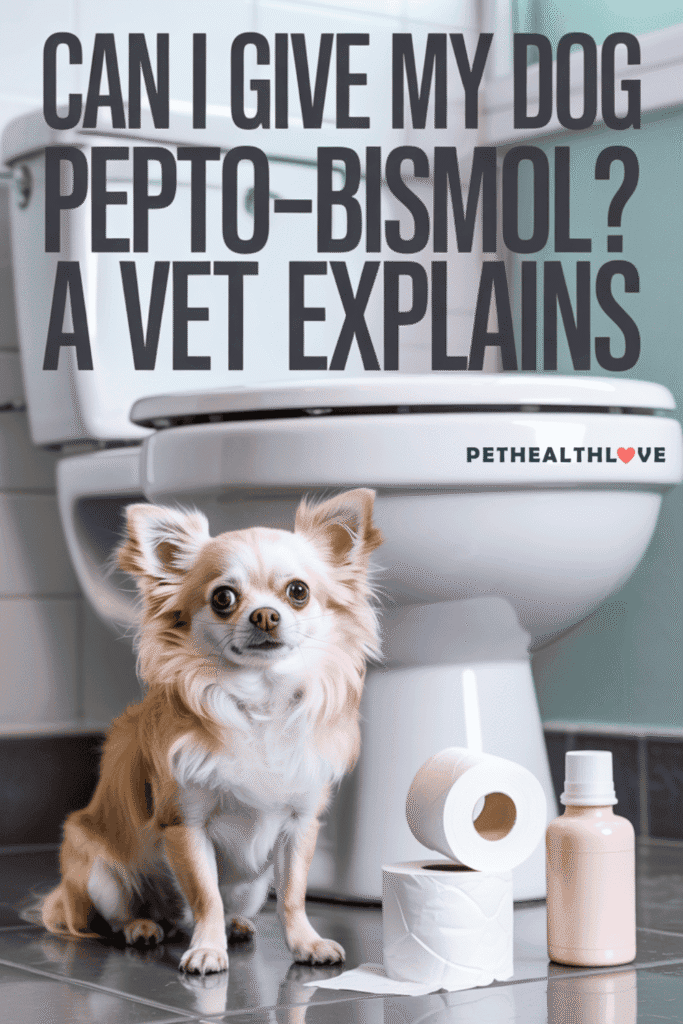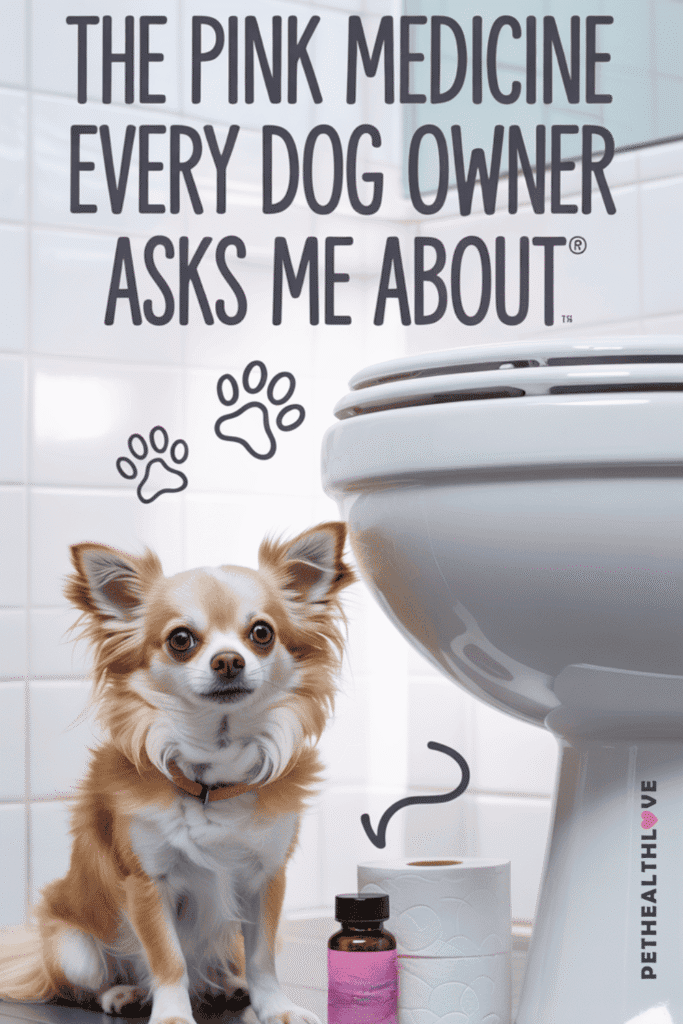Last updated on August 9th, 2025 at 02:05 am
As a veterinarian, I get this question all the time:
“My dog has diarrhea—can I give them Pepto-Bismol?”
It’s tempting to reach for that pink bottle when your dog suddenly seems quiet, skips a meal, or has loose stool during a walk. But while Pepto might seem like a quick fix, it’s not always safe—and in some cases, it can make things worse.
In this post, I’ll break down when Pepto-Bismol might be used in dogs, the risks to know about, and safer vet-recommended alternatives for upset stomach and diarrhea.
Affiliate Disclaimer: This post may contain affiliate links, which means we may earn a small commission if you purchase something through our links. This helps support our website and allows us to continue providing valuable content. See our full disclosure here.
What Is Pepto-Bismol and How Does It Work?
Most of us know of Pepto-Bismol being a popular over-the-counter medication used by humans to treat symptoms like heartburn, nausea, indigestion, upset stomach and diarrhea (thanks to their catchy commercials). The active ingredient is bismuth subsalicylate, which is a combination of bismuth (a mineral) and salicylate (a compound related to aspirin).
In people, bismuth subsalicylate works in a few ways:
It coats the stomach lining, helping to protect it from irritation.
It has mild anti-inflammatory and antibacterial effects, which can reduce inflammation in the gut and help calm down diarrhea.
It slows down movement in the intestines, which can help firm up loose stools.
While this sounds like it could be helpful, especially when your dog has diarrhea on your expensive rug, Pepto-Bismol isn’t always safe or effective for pets. In fact, the salicylate component (related to aspirin) can be super risky for dogs—especially if they’re already on other meds or have a chronic health condition.
When Might Pepto-Bismol Be Used in Dogs?
Pepto-Bismol may be used in dogs—but only in very specific situations and always under veterinary guidance.
In rare, mild cases of gastrointestinal upset—like simple cases of temporary diarrhea from eating something unusual or minor stress—some veterinarians might approve a short course of Pepto-Bismol. But this is typically a one-time dose or used for no more than a day or two.
Even then, it’s not the immediate go-to treatment. That’s because the salicylate in Pepto-Bismol (a compound similar to aspirin) can be toxic to dogs in the wrong dose or if used too frequently. It can also interact with other medications your dog might be taking, including anti-inflammatories, steroids, antibiotics, and blood thinners.
As a vet, I can almost always tell when a dog has been given Pepto-Bismol—even before the owner says a word. By day three or four of ongoing diarrhea, they show up at the clinic with telltale pink stains on their dog’s mouth, chin, and even their front paws. It’s like a neon sign that says, “Tried the Pepto first.” 😅
While I totally understand wanting to help at home, that bright pink mess is usually a clue that the stomach issues haven’t improved—and sometimes, they’ve actually gotten worse.
If your dog has an upset stomach, it’s much safer to check in with your vet first. We may recommend a bland diet, probiotics, or safer medications instead.
ALSO-
I do not recommend using Pepto Bismol for vomiting. I mean – how will they keep the Pepto down if they are vomiting??
If your pet is vomiting (and also having diarrhea), skip the Pepto. It is time to schedule an appointment for your pup with the doctor. Tests like lab work, a parasite exam and abdominal x-rays may be warranted to look for the underlying cause of vomiting and diarrhea.
What Are the Risks and Side Effects of Pepto-Bismol for Dogs?
While Pepto-Bismol may be safe for some dogs in very specific situations, it also comes with potential hazards.
Possible side effects include:
- Changes in stool color – stool may turn green, gray, or black.
- Constipation – usually temporary.
- Tongue discoloration – harmless but surprising to see.
- Masking signs of bleeding – black stool from Pepto can hide internal bleeding.
More serious risks:
- Ulcers or gastrointestinal bleeding – especially in dogs taking NSAIDs, steroids, or with pre-existing stomach issues.
- Drug interactions – can interact with antibiotics (like doxycycline), anticoagulants, ACE inhibitors, prednisone, and other medications.
- Underlying conditions – not recommended for young puppies, pregnant or nursing dogs, those with bleeding disorders, or dogs on certain medications.
- Kidney damage or toxicity – possible with prolonged or high-dose use.
- Potential gastrointestinal foreign body confusion – bismuth in Pepto can appear as a round metallic object (like a coin) on X-rays, so always tell your vet if you’ve given it.
⚠️ Never give Pepto-Bismol to cats—even small amounts can be toxic to them.
What Are Safer Alternatives to Pepto-Bismol for Dogs?
If your dog has mild diarrhea or an upset stomach, there are safer options you can try—especially while you’re waiting to check in with your vet.
1. Bland diet
Feeding a bland diet for a day or two can help rest the digestive system. I often recommend:
Boiled, skinless chicken (no seasoning, bones, or skin)
Plain white rice
Plain canned pumpkin (not pumpkin pie filling) for added fiber
These ingredients are gentle on the stomach and can help firm up stool.
2. Probiotics
Dog-safe probiotics help restore the balance of healthy bacteria in the gut. They can be given as powders, capsules, or a paste.
Nutramax Proviable Probiotics for Dogs
**This is my favorite brand of probiotics. I typically prescribe this product for almost every case of diarrhea I see.
3. Hydration support
I often recommend offering fresh water at all times along with small amounts of low-sodium chicken broth or unflavored Pedialyte. These can encourage your dog to drink more and help replace lost fluids and electrolytes—just be sure to introduce them gradually to avoid worsening diarrhea.
Pepto Bismol Dosage for Dogs
Pepto Bismol comes in three different forms: chewable tablets, liquid, and caplets.
The liquid form comes in Regular and Ultra Strength. DO NOT use the Ultra Strength as it has twice the amount of active ingredient. Do not give the caplets also.
Just stick to giving the liquid or chewable tablets.
Pepto Bismol Liquid (Regular Strength) – 1 teaspoon or 5 ml per 10 pounds of body weight every 6 to 8 hours but no more than two to three doses or for longer than 24 hours.
There are two ways you can give Pepto liquid to your dog – through a syringe if you have one handy, or by getting him or her to lick it off of a spoon. If you happen to have a syringe, you can pull up the dose, and squirt the liquid into the corner of their mouth.
Pepto Bismol Tablets (262mg per tablet) – The dose is 8.5mg per 1 pound of body weight. So a 10lb dog would need approximately 85mg, which is about a third of a tablet. Be careful when cutting tablets as it can be easy to give your dog a higher dose than they should get.
With the tablet, there are two ways you can give it – hiding the tablet in a treat or a pill pocket or allowing your dog to chew the medicine like it is a treat.
Fun Fact: I can always tell when an owner gives their dog Pepto because I will see the pink staining on the fur around the mouth or on their front paws. That usually means they did not take it well OR tried to spit it out and the pink stuff landed on their front feet. And that ultimately means that Pepto didn’t work for the poor dog and it was time for me to work my magic to help him feel better.
When Should I Call the Vet Immediately?
RED FLAG signs to watch for include:
- Blood in the stool – either bright red or black/tarry
- Persistent vomiting – especially if your dog can’t keep water down
- Severe lethargy or weakness – not wanting to move or play
- Signs of dehydration – dry or sticky gums, sunken eyes, skin that doesn’t spring back when gently pinched
- Abdominal pain – whining, restlessness, or a hunched posture
- Diarrhea lasting more than 24–48 hours
If you’re ever unsure, it’s always safer to err on the side of caution and check in with your vet. Diarrhea can sometimes be the first sign of a serious condition that needs immediate treatment.
The Bottom Line on Pepto-Bismol for Dogs
While Pepto-Bismol can sometimes be used in dogs, it’s not without risks—and it’s never a substitute for proper veterinary care. The safest first steps for a mild upset stomach are keeping your dog hydrated and offering a short-term bland diet like boiled chicken and rice.
If you’re considering Pepto-Bismol, talk to your veterinarian first so they can confirm the right dose (if it’s appropriate at all) and rule out any dangerous interactions or underlying conditions. And if your dog’s symptoms last more than a day or two, or you notice any red-flag signs, skip the home remedies and head straight to the clinic.
Your dog’s digestive system is more sensitive than you might think—and a quick call to your vet can make all the difference in helping them feel better, faster, and safer.
For the love of pets,
Dr. Gina
Looking for more help with your dog’s tummy troubles? Check out these related posts🐾
The Monsters Inside: What Pet Owners Should Know About Giardia In Dogs
Bland Diet for Dogs – What to Feed & When to Use It
When Is Dog Diarrhea An Emergency? A Guide For Pet Owners
Why Is My Dog Throwing Up Yellow Bile?


















Leave feedback about this